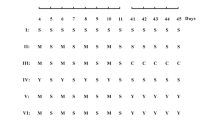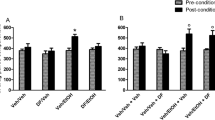Abstract
Objective
Nitric oxide is a neural messenger molecule in the central nervous system that is generated from L-arginine via the nitric oxide synthase (NOS) and is involved in many important oplold-induced effects. In Iranian ancient medicine, Cuminum cyminum L (green seed) has been used for the treatment of some diseases. In the present study, the effect of intraperitoneal (ip) administration of different doses of cumin fruit essential oil (FEO) on the acquisition of morphine-induced conditioned place preference (GPP) in L-arginine-treated mice was investigated.
Methods
A total of 213 adult male albino Wistar mice were used in these experiments. The CPP paradigm was carried out in 5 continuous days, pre-conditioning, conditioning and post-conditioning. Animals were randomly assigned to one of the two groups for place conditioning. CPP was induced by subcutaneous (sc) injection of morphine (5 mg/kg) in 3 days conditioning schedule. On the test day, conditioning scores and locomotor activity were recorded by Ethovision software.
Results
Sole administration of different doses of cumin FEO (0.01%, 0.1%, 0.5%, 1% and 2%; lp) or L-arginine (50, 100 and 200 mg/kg; lp) during the CPP protocol could not induce CPP. Nonetheless, morphine-induced CPP was decreased by different doses of cumin FEO (0.01%–2%), whereas it was increased by L-arginine (50-200 mg/kg) when they were injected before morphine (5 rug/kg) during a 3-day conditioning phase (acquisition period). Additionally, cumin FEO could interestingly attenuate the raising effect of L-arginine on morphine-induced CPP in a dose-dependent manner.
Conclusions
It is suggested that some components of the Cuminum cyminum L. seed attenuate the excessive effect of L-arginine on morphine-induced CPP through the NOS inhibitory mechanism. It seems that cumin FEO possibly acts as a NOS inhibitor.
Similar content being viewed by others
References
Carr G, Fibiger H, Phillips A. Conditioned place preference as a measure of drug reward. In: Liebman JM, Cooper SJ, ed. The neuropharmacological basis of reward. New York: Oxford University Press; 1989:264–319.
Shippenberg TS, Heidbreder C, Lefevour A. Sensitization to the conditioned rewarding effects of morphine: pharmacology and temporal characteristics. Eur J Pharmacol 1996;299:33–39.
Risinger F, Oakes R. Nicotine-induced conditioned place preference and conditioned place aversion in mice. Pharmacol Biochem Behav 1995;51:457–461.
Rizos Z, Ovari J, Leri F. Reconditioning of heroin place preference requires the basolateral amygdala. Pharmacolo Biochem Behav 2005;82:300–305.
Kolesnikov YA, Pick CG, Pasternak GW. NG-nitro-L-arginine prevents morphine tolerance. Eur J Pharmacol 1992;221:399–400.
Karami M, Zarrindast MR, Sepehri H, Sahraei H. Sulpiride injections into the medial septum reverse the influence of intra-medial septum injection of L-arginine on expression of place conditioning-induced by morphine in rats. Brain Res 2003;976:30–40.
Kivastik T, Rutkauskaite J, Zharkovsky A. Nitric oxide synthesis inhibition attenuates morphine-induced place preference. Pharmacol Biochem Behav 1996;53:1013–1015.
Garthwaite J, Southam E, Anderton M. A kainate receptor linked to nitric oxide synthesis from arg i nine. J Neu roch em 1989;53:1952–1954.
Ohno M, Arai I, Watanabe S. N-methyl-D-aspartate stimulates dopamine release through nitric oxide formation in the nucleus accumbens of rats. Brain Res 1995;699:332–335.
Hong JT, Kim HC, Kim HS, Lee YM, Oh KW. The role of nitric oxide on glutaminergic modulation of dopaminergic activation. Pharmacol Res 2005;52:298–301.
Kiss JP, Vizi ES. Nitric oxide: a novel link between synaptic and nonsynaptic transmission. Trends Neurosci 2001;24:211–215.
Sahraei H, Zarei F, Eidi A, Oryan S, Shams J, Khoshbaten A, et al. The role of nitric oxide within the nucleus accumbens on the acquisition and expression of morphine-induced place preference in morphine sensitized rats. Eur J Pharmacol 2007;556:99–106.
Swerdlow JL. Nature’s medicine, plants that heal A chronicle of mankind’s search for healing plants through the ages. National Geographic; 2000.
Haghparast A, Shams J, Khatibi A, Alizadeh AM, Kamalinejad M. Effects of the fruit essential oil of Cuminum cyminum Linn. (Apiaceae) on acquisition and expression of morphine tolerance and dependence in mice. Neurosci Lett 2008;440:134–139.
Haghparast A, Zarringhalam J, Khatibi A, Dianati E, Shams J. The fruit essential oil of Cuminum cyminum L. reduced the acquisition but not expression of ineffective dose of morphine-induced conditioned place preference in morphine-sensitized Mice. J Med Plants 2009;8:72–82.
Khatibi A, Haghparast A, Shams J, Dianati E, Komaki A, Kamalinejad M. Effects of the fruit essential oil of Cuminum cyminum L. on the acquisition and expression of morphine-induced conditioned place preference in mice. Neurosci Lett 2008;448:94–98.
Zargari A. Medical plants. Tehran, Iran: Tehran University Press; 1994:1–33.
Jalali-Heravi M, Zekavat B, Sereshti H. Use of gas chromatography-mass spectrometry combined with resolution methods to characterize the essential oil components of Iranian cumin and caraway. J Chromatogr A 2007;1143:215–226.
Kitajima J, Ishikawa T, Fujimatu E, Kondho K, Takayanagi T. Glycosides of 2-C-methyl-D-erythritol from the fruits of anise, coriander and cumin. Phytochem 2003;62:115–120.
Peana AT, Marzocco S, Popolo A, Pinto A. (-)-Linalool inhibits in vitro NO formation: probable involvement in the antinociceptive activity of this monoterpene compound. Life Sei 2006;78:719–723.
Xu LL, Zou K, Wang JZ, Wu J, Zhou Y, Dan FJ, et al. New polyhydroxylated furostanol saponins with inhibitory action against NO production from Tupistra chinensis rhizomes. Molecules 2007;12:2029–2037.
Azizi P, Haghparast A, Hassanpour-Ezatti M. Effects of CB1 receptor antagonist within the nucleus accumbens on the acquisition and expression of morphine-induced conditioned place preference in morphine-sensitized rats. Behav Brain Res 2009;197:119–124.
Moaddab M, Haghparast A, Hassanpour-Ezatti M. Effects of reversible inactivation of the ventral tegmental area on the acquisition and expression of morphine-induced conditioned place preference in the rat. Behav Brain Res 2009;198:466–471.
Haghparast A, Azizi P, Hassanpour-Ezatti M, Khorrami H, Naderi N. Sub-chronic administration of AM251, CB1 receptor antagonist, within the nucleus accumbens induced sensitization to morphine in the rat. Neurosci Lett 2009;467:43–47.
Heinmiller A, Ting AKR, Vargas-Perez H, Yeh A, van der Kooy D. Tegmental pedunculopontine glutamate and GABA-B synapses mediate morphine reward. Behav Neurosci 2009;123:145–155.
Capone F, Adriani W, Shumilina M, Izykenova G, Granstrem O, Dambinova S, et al. Autoantibodies against opioid or glutamate receptors are associated with changes in morphine reward and physical dependence in mice. Psych op harmacol 2008;197:535–548.
Gholami A, Zarrindast MR, Sahraei H, Haerri-Rohani A. Nitric oxide within the ventral tegmental area is involved in mediating morphine reward. Eur J Pharmacol 2003;458:119–128.
Zarrindast M, Karami M, Sepehri H, Sahraei H. Influence of nitric oxide on morphine-induced conditioned place preference in the rat central amygdala. Eur J Pharmacol 2002;453:81–89.
Gholami A, Haeri-Rohani A, Sahraie H, Zarrindast M. Nitric oxide mediation of morphine-induced place preference in the nucleus accumbens of rat. Eur J Pharmacol 2002;449:269–277.
Author information
Authors and Affiliations
Corresponding author
Additional information
Supported by the grant (No. 88-892-A) from Neuroscience
Rights and permissions
About this article
Cite this article
Kermani, M., Azizi, P. & Haghparast, A. The role of nitric oxide in the effects of cumin (Cuminum Cyminum L.) fruit essential oil on the acquisition of morphine-induced conditioned place preference in adult male mice. Chin. J. Integr. Med. (2012). https://doi.org/10.1007/s11655-011-0939-0
Received:
Published:
DOI: https://doi.org/10.1007/s11655-011-0939-0




